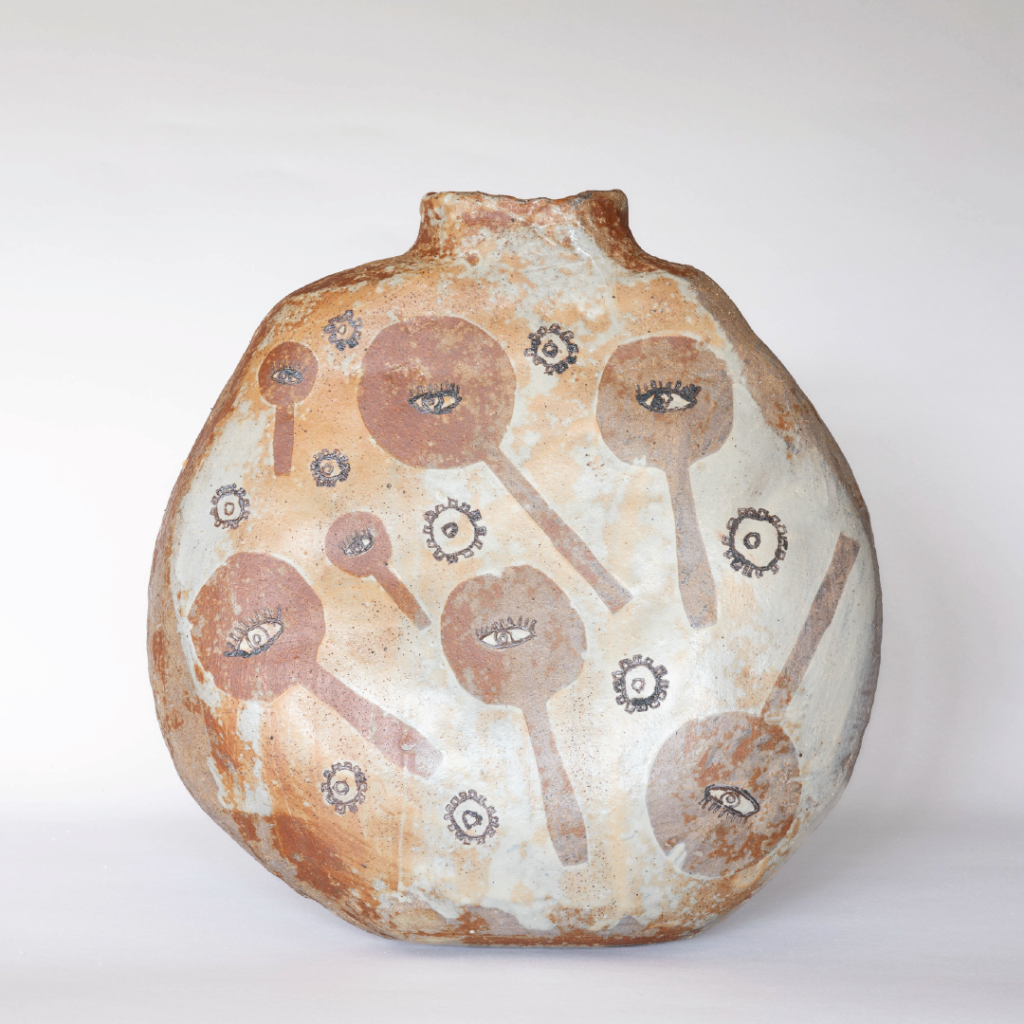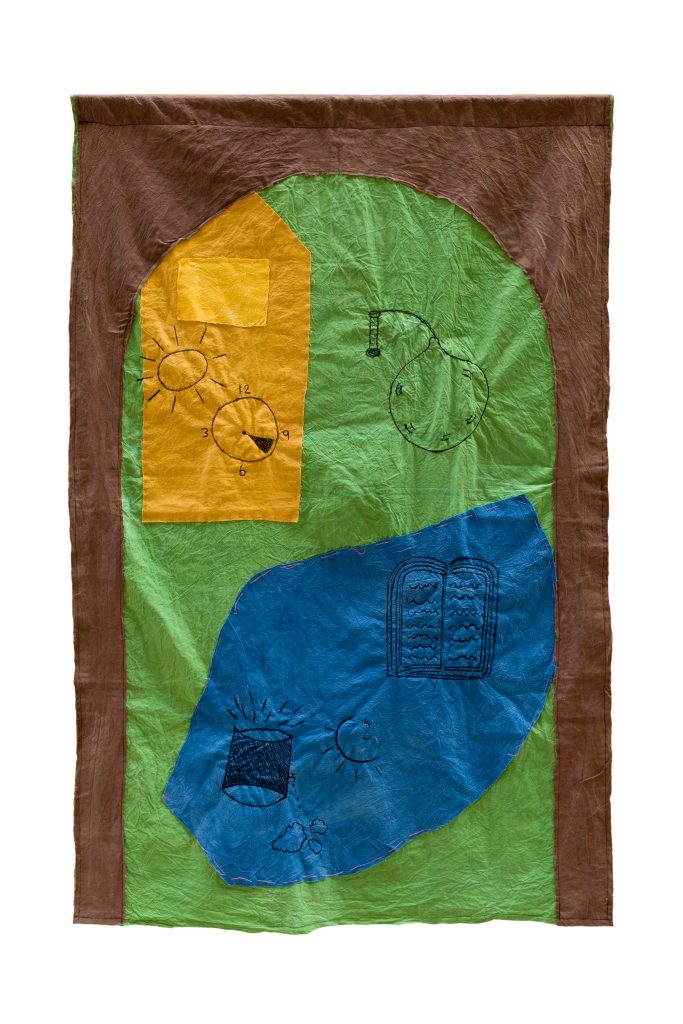Landmark is an art project created through collaboration between artists Emilie Taylor and Christopher Jarratt and eleven people they met at Project 6, a drug and alcohol support service.
On a baking hot day in Sheffield, I meet six of those eleven, Sam, Ben, Ruth, Matt, Lee and Dave. Along with Emilie and Christopher, who details the concept at the heart of the project: “We wanted to map and tell the stories of people’s journeys and moments of great change in their lives through the languages of imagery, colour and craft. Inspired by the symbolism from Sheffield’s past, we settled on pilgrim flasks and banners as the artefacts to hold and tell these stories.”
We meet in the yard of Yorkshire Artspace, with the pilgrim flasks laid out, their glazes glinting in the sun. I ask the group what they thought of these themes when they were presented with them. Lee says, “We were going in blind. But I like history, and the images shown by Chris and Emilie, the references were medieval, so I was quite happy with that. The broader context of us all going on a pilgrimage, that’s what we’ve done through this process.”
Christopher responds, “When we presented it, I did sense some hesitation, understandably so, but everyone got on board. Dealing with hard things in your life, if you can abstract them a bit, I think it helps. Embedding our stories into craft I feel is one of the most ancient and effective ways of making sense of the world.”
They met every Friday over 14 weeks, beginning each session talking about whatever came up for them, then drawing and printing in response. Lee details the impact this process had on them: “The most evocative part, drawing something every week, from our thoughts and feelings, opened up something new. That really connected us, was the glue that tied us in.”
After talking and drawing, they moved to creating objects. For the first seven weeks, they crafted the clay pilgrim flasks. For the remaining seven, they dyed and sewed large cloth pennants.
Emilie says, “Making the drawings and letting what was under the surface speak could be emotionally deep and very heavy. Moving into material processes offered a way to sit with the weight of feeling in the room. Craft holds space. There were times, I remember dyeing the fabric after very difficult conversations, the mood transformed into all of us having an absolute riot.”

“We had big buckets. We did it as a communal thing,” Sam recalls. They tell me the wind was up the day they did the dyeing. Ruth points to the BBC building behind us, “we had visions of having to go to Radio Sheffield to get our flags back!”
Locations around the city that had significant meanings to individual group members became a focus as the project developed. They decided to dedicate one session to visiting places they’d each chosen. After arriving, they’d share what it meant to them and this was audio recorded. Later, footage was taken of the places and merged with the audio to create a film which forms part of the project.
It’s clear this revisitation of locations which held strong and sometimes painful memories had a significant impact on them. Ruth says, “My place was the Millennium Gallery; I went in again recently. It’s almost like it’s been exorcised from me, through this process. I used to only associate it with bad things, but it’s very different now for me.”
Dave agrees, “Like the park, I have found peace with it now. I go and sit at the bridge and listen to the running water. It’s that journey.”
The film is quietly meditative, its long, drawn out shots of the locations soundtracked by the group members’ heartfelt reflections. It creates an alternative map of the city through the lived experience of these individuals. Ben says of the final film, “Some of it was traumatic, but the sense of recovery and hope, that overrides any of that harrowing stuff. It was very honest, it needed to be spoken about.”
I ask about the images they chose for their flasks and banners. “I drew a wheelie bin full of empty wine bottles,” Ruth explains. “I never realised how much stress that would cause me during my addiction. I like to listen now when they empty my bin, it’s not the nosiest, not the heaviest on the street anymore. But I’d not dealt with that; it was still in there. This has aided my healing, to me forgiving myself.”
Ben says, “The symbols on my flask, I initially described them very matter of factly, they’re just magnifying glasses with eyes. Then someone said they’re quite surreal. And then I talked about how at the time I was under so much scrutiny with psychiatrists, and it links to being under that lens, stigmatised by society.”
Landmark is being exhibited in September 2022, Recovery Month, at Yorkshire Artspace and also on billboards across Sheffield. Emilie links this back to the original concept: “Pennants would have once hung from Sheffield Castle ramparts, welcoming travellers home. The flags of journeys travelled today will hang across the city on advertising hoardings.”
“For me what’s important about the banners being detached from the exhibition,” says Lee, “is if someone is driving past, they’ll be like ‘what’s that’, it will reach a far bigger audience.” The billboards will feature QR codes, to encourage people to find out more. “They will go on a journey with us. There’s a lot more to say,” he concludes.

I ask the group, looking back now, what difference they think the project has made to them. “I have grown and made myself well through this process,” Ben says. “Of course it’s been alongside therapy and other things I engage with, but this has helped no end.”
“I have a friend who has been supportive through my recovery,” Ruth says, “but doesn’t get it, me taking part in a project like this. Why would she. I didn’t get it either, before I came. It’s made me braver, to try new things. My confidence has grown.”
Christopher and Emilie collaborated with an existing community, one whose bonds were forged through the recovery process. Through this, a new temporary creative community was formed. I ask them both if they see initiating this formation as part of their artistic practice, alongside their creative skills. Christopher responds, “In short, yes. I want people to feel empowered and gain a sense of ownership over space and place through learning, skill sharing and creating work with a legacy and an inherent quality.”
Formally trained artists and those not formally trained coming together to share time, skills, knowledges and experiences and create something in collaboration, has a long tradition. It is given many different names, social practice, community art, etc, but the kernel of why it can be powerful is how it can carve a new space for all of those involved.
Exploring and exposing parts of your inner self through making art can be a challenging process. This can contribute to personal development and healing. But in creating these works around their experiences of recovery, the group have also opened up new channels for others engaging with the artworks to reflect on their own lives. Expanding communication across dividing lines. At a fundamental level, contributing to us understanding ourselves and each other better.
Lee says, “I have got hardened to the prejudice and the stigma; I can play out how it is going to go. It doesn’t define me as a person.” Those dealing with addiction, like many with less power in society, so often have their stories defined by others. Having access to your own forms of creative expression, being encouraged and given a platform for them, is essential in people being able to turn that around and speak directly of their own experiences to others. Doing this is a reclaiming of power. And it is partially because of how powerful this can be, that such access to creative expression is frequently denied and discouraged in people, one way or another.
The more you get used to expressing yourself, the more comfortable it can feel. Earlier steps though require bravery and often support. Chris unfolds some of the bright and bold banners that will soon be seen around Sheffield. I ask the group if they plan to carry on their creativity after Landmark. There is a chorus of agreement. Two members of the group have recently enrolled in degrees, influenced by taking part in the project.
“It’s reawakened in me a passion I have always had for art,” Ben says enthusiastically. “I will definitely be continuing the journey.”
Lee agrees, “I have started to write poems again and I have carried that on. It’s a nice creative process for me and I don’t think I would have done that if it wasn’t for this project.”
Dave sums up, “We’re waiting for the next one.”
By Kenn Taylor
Landmark is open throughout September at Persistence Works, Sheffield
